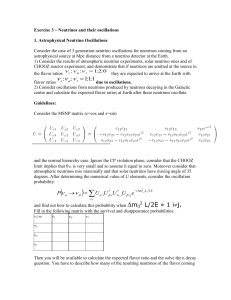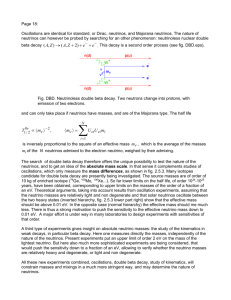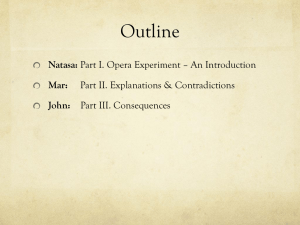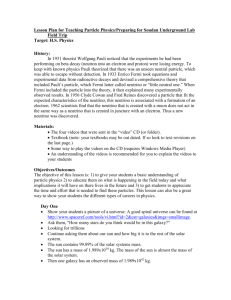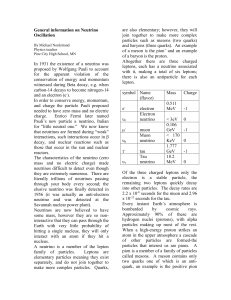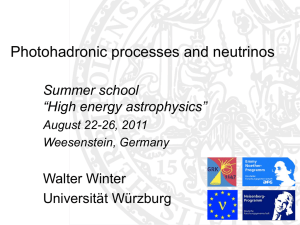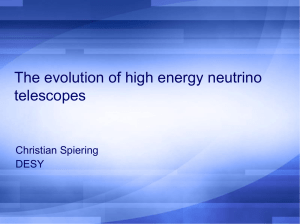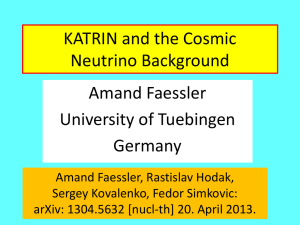Neutrinos_English_final
advertisement
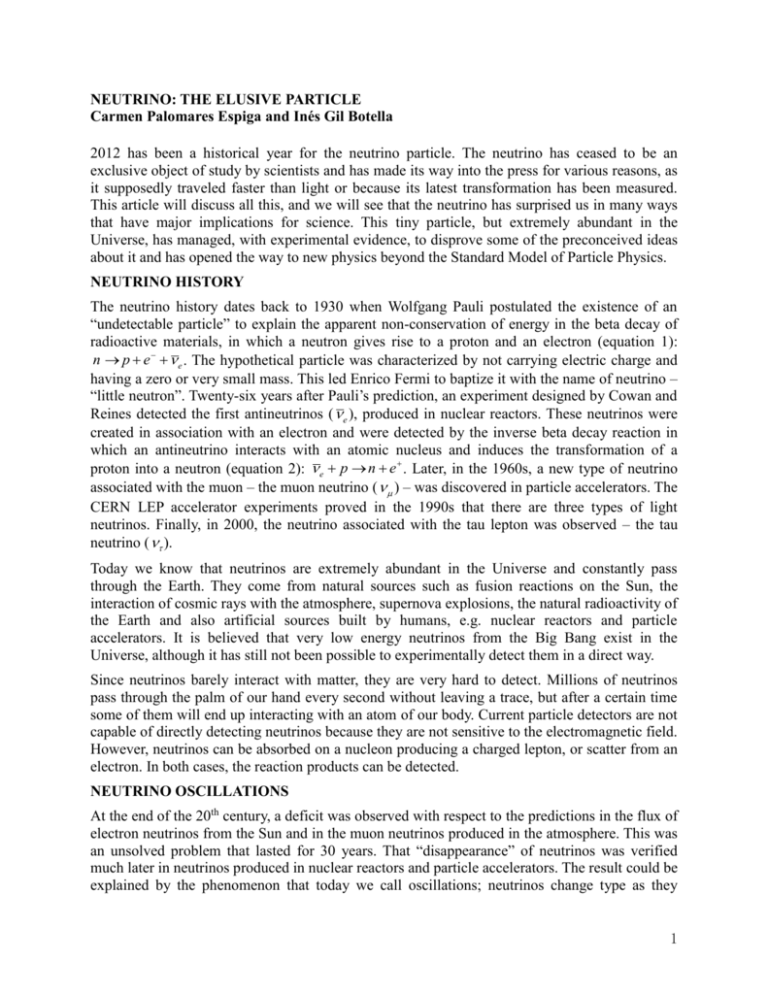
NEUTRINO: THE ELUSIVE PARTICLE Carmen Palomares Espiga and Inés Gil Botella 2012 has been a historical year for the neutrino particle. The neutrino has ceased to be an exclusive object of study by scientists and has made its way into the press for various reasons, as it supposedly traveled faster than light or because its latest transformation has been measured. This article will discuss all this, and we will see that the neutrino has surprised us in many ways that have major implications for science. This tiny particle, but extremely abundant in the Universe, has managed, with experimental evidence, to disprove some of the preconceived ideas about it and has opened the way to new physics beyond the Standard Model of Particle Physics. NEUTRINO HISTORY The neutrino history dates back to 1930 when Wolfgang Pauli postulated the existence of an “undetectable particle” to explain the apparent non-conservation of energy in the beta decay of radioactive materials, in which a neutron gives rise to a proton and an electron (equation 1): n p e e . The hypothetical particle was characterized by not carrying electric charge and having a zero or very small mass. This led Enrico Fermi to baptize it with the name of neutrino – “little neutron”. Twenty-six years after Pauli’s prediction, an experiment designed by Cowan and Reines detected the first antineutrinos ( e ), produced in nuclear reactors. These neutrinos were created in association with an electron and were detected by the inverse beta decay reaction in which an antineutrino interacts with an atomic nucleus and induces the transformation of a proton into a neutron (equation 2): e p n e . Later, in the 1960s, a new type of neutrino associated with the muon – themuon neutrino ( ) – was discovered in particle accelerators. The CERN LEP accelerator experiments proved in the 1990s that there are three types of light neutrinos. Finally, in 2000, the neutrino associated with the tau lepton was observed – the tau neutrino ( ). Today we know that neutrinos are extremely abundant in the Universe and constantly pass through the Earth. They come from natural sources such as fusion reactions on the Sun, the interaction of cosmic rays with the atmosphere, supernova explosions, the natural radioactivity of the Earth and also artificial sources built by humans, e.g. nuclear reactors and particle accelerators. It is believed that very low energy neutrinos from the Big Bang exist in the Universe, although it has still not been possible to experimentally detect them in a direct way. Since neutrinos barely interact with matter, they are very hard to detect. Millions of neutrinos pass through the palm of our hand every second without leaving a trace, but after a certain time some of them will end up interacting with an atom of our body. Current particle detectors are not capable of directly detecting neutrinos because they are not sensitive to the electromagnetic field. However, neutrinos can be absorbed on a nucleon producing a charged lepton, or scatter from an electron. In both cases, the reaction products can be detected. NEUTRINO OSCILLATIONS At the end of the 20th century, a deficit was observed with respect to the predictions in the flux of electron neutrinos from the Sun and in the muon neutrinos produced in the atmosphere. This was an unsolved problem that lasted for 30 years. That “disappearance” of neutrinos was verified much later in neutrinos produced in nuclear reactors and particle accelerators. The result could be explained by the phenomenon that today we call oscillations; neutrinos change type as they 1 propagate. This was experimentally demonstrated for the first time by the Super-Kamiokande (SK) experiment. This detector, a 50,000 ton water tank located 1000 m underground in a mine in Japan, was able to demonstrate that atmospheric neutrinos, on their way through the Earth, are transformed from muon neutrinos into tau neutrinos. SK measured a deficit of muon neutrinos with respect to those expected based on the distance traveled and the neutrino energy, unambiguously proving that neutrinos oscillate. This capacity of transmutation between families of neutrinos is only possible, according to quantum mechanics, if neutrinos have mass. This mass can be infinitesimal but it has to be different from zero. This is in contradiction with the predictions of the Standard Particle Model, which assumes that neutrinos are massless. Neutrinos are born and are detected by the weak interaction as electron, muon or tau neutrinos, called “flavor eigenstates”, with an indefinite mass. However, they propagate as defined mass eigenstates, which are labeled as “1”, “2” and “3”. For example, in the case of oscillations between two types of neutrinos, if masses m1 and m2 are different, these neutrino “mass eigenstates” can be a mixture of flavors: 1 cos e sin . The value of the angle θ defines the proportion of neutrinos of a certain flavor that contains the mass eigenstate 1 and gives the probability, when a neutrino interacts, that it will do so according to one type or another. The probability that a e will be detected as it was created is given by equation (3): 2 2 2 2 (m2 m1 )L P( e e ) 1 sin 2 sin 4E . As we can see, this probability depends not only on θ but also on the difference between the squared masses of states 1 and 2 (m221 = m22 - m12), the distance traveled by the neutrino (L) and the energy of that neutrino (E). In fact, the frequency of the oscillation is determined by the value of (m22 m12 )L / E , whereas the amplitude is defined by the angle θ. The oscillation probability from one flavor to another involving three-neutrino mixing will depend on two mass squared differences (m221 and m231), three mixing angles (12, 23, 13) and an extra parameter that makes neutrinos and antineutrinos behave differently – the so-called “CP violation phase”. The 12 and 23 mixing angles and the two mass differences, which govern the oscillations of solar and atmospheric neutrinos, were measured in several experiments (KamLAND, SNO, SK, K2K, T2K, MINOS) using different neutrino sources. However, it is not known which of the three neutrinos is the heaviest, i.e., the so-called mass hierarchy. As for the third angle 13, until last year it was only known that it was very small and could even be zero. 13 controls the fraction of e in the neutrino corresponding to mass m3, and therefore it influences the transformation of the neutrino e into other neutrino flavors. Its importance lies in the fact that, if it is not zero, it would open the door to the possibility of measuring the CP violation in the lepton sector. This mechanism is one of the keys for understanding why, in the instants after the BigBang, matter prevailed over antimatter and gave rise to the Universe that we know today. Fortunately, 13 was experimentally measured in 2012 thanks to the T2K experiment on one hand, which for the first time has detected the appearance of e in a neutrino beam, and primarily thanks to neutrino experiments in nuclear reactors, and in particular the Double Chooz experiment. DOUBLE CHOOZ AND CIEMAT 2 The Double Chooz experiment [1] is installed in the French Chooz nuclear power plant, and its main goal is to measure the 13 mixing angle. Because of the continuous beta decays of the nuclear fission products, the flux of antineutrinos is very high; around 16 x 1020 neutrinos per second are produced. This compensates for the low probability of detecting them. In this case, the survival probability is similar to that of equation 3. The distance at which the oscillation occurs depends on m231 and the neutrino energy, which are known quantities. Therefore, we know that the maximum probability of oscillation will be at approximately 1 Km from the reactors. However, the amount of oscillated antineutrinos depends on the value of 13. Double Chooz (figure 1) has two identical underground detectors located 400 and 1050 meters, respectively, from the Chooz reactors. The near detector measures the flux at a place where there is no oscillation, whereas the far detector measures it where the oscillation is at a maximum. The effect of this oscillation is observed in the far detector as a deficit of neutrinos with respect to those detected by its counterpart; when electron antineutrinos are converted into antineutrinos of another family, they do not leave a trace in the detector. Reactor neutrinos are detected by the inverse beta decay reaction (equation 2), in which the neutrino interacts with a proton emitting a positron (which loses energy and annihilates, producing photons) and a neutron, which is subsequently captured by another nucleus that deexcites by emitting photons. The signature of this reaction is the time coincidence of two energy depositions in the detector (one from the positron and the other from the neutron) delayed about 30-microseconds. The Double Chooz detectors (figure 2) consist of two concentric vessels filled with liquid scintillator of different characteristics. The energy deposited by the products of the neutrino interaction is transformed into light as a result of the liquid scintillation properties. This light is captured by the detector “eyes” (390 photomultipliers installed in a tank that surrounds the vessels) and transformed into electric charge, from which the original energy of the neutrino is inferred. This enables reconstruction of its energy spectrum. Double Chooz is currently in its first phase taking data with the far detector since April 2011. The near detector is under construction and the second phase of the project will begin in the spring of 2014, when both detectors are operative. Even though the maximum sensitivity to 13 will not be achieved until then, Double Chooz has already been able to provide the first measurement of 13 in reactors with data from a single detector in November 2011, using a very accurate prediction of the neutrino flux. Double Chooz has measured a deficit of electron antineutrinos from the nuclear plant 1 km away from the reactors, and it has observed the distortion in the antineutrino energy spectrum, demonstrating the disappearance of the neutrinos due to oscillations. Figure 3 shows the spectrum of the 8249 neutrinos (points) measured over 227.9 days of data acquisition with respect to the 8936.8 neutrinos expected in case of no oscillations (blue dotted line) and the best fit to the data (red line) in the case of oscillations. This fit provides a mixing angle value of sin2213 = 0.109 ± 0.039. Therefore, the possibility of nonzero 13 is excluded with a probability of 99.8%. These results have been later confirmed by other experiments in nuclear reactors in China and Korea. In the coming years, Double Chooz will improve the precision of the 13 measurement thanks to increased statistics and the use of its two detectors. Because the value of 13 is higher than expected, the possibilities of measuring CP violation in the lepton sector with conventional neutrino beams in the next few years have increased. The CIEMAT experimental neutrino physics group is actively participating in the Double Chooz 3 experiment, both in the construction, installation and commissioning of the detectors and in the data taking and subsequent analysis. NEUTRINO MASS Any measurement that involves neutrinos is very complicated but the measurement of their mass is perhaps the hardest, considering how extremely small it is – a million times less than the electron mass, which in turn is a thousand times lighter than the proton. It is not possible to get information on the absolute neutrino mass value from oscillation experiments, since the probability of one type of neutrino oscillating to another is proportional to the difference between their squared masses. The effects of the neutrino mass itself can be observed in phenomena such as weak nuclear and particle decays, in which the energy and momentum of the decay products depend on the neutrino mass. These methods are called “direct” and to date they have only managed to set upper limits, primarily thanks to the analysis of the energy spectrum of the electron produced in tritium beta decay: m(νe) < 2.3 eV [2]. New experiments may soon be able to measure masses of up to some 0.2 eV. There are other kinds of processes that can “indirectly” obtain information on neutrinos, since their amplitude depends on the value of the neutrino mass. The most promising is the neutrinoless double beta decay, which can only happen if the neutrino is a Majorana particle (i.e., if neutrino and antineutrino are the same particle) – which is still unknown – and if the neutrino has mass. The two electrons produced in the decay would provide a clear signature of this process, which would enable its detection in spite of its low probability. At present there are several experiments under way that are trying to detect this rare decay, but to date they have only succeeded in setting an upper limit on the neutrino mass of 0.3-0.6 eV [3]. NEUTRINOS AND COSMOLOGY Cosmology also provides valuable information on neutrino mass and other properties such as the number of families, as these are a fundamental ingredient of the Universe. Neutrinos must have been the first particles to decouple from the primordial plasma 1 s after the Big Bang; they continued to diffuse and cool in the expanding Universe until arriving in our era as a neutrino background. Due to the very low energy of these neutrinos (less than 1 eV – one million times less than that of neutrinos produced by a nuclear power plant), the probability that they will someday be directly detected is extremely low. However, their existence is known thanks to indirect measurements of cosmological observables such as anisotropies of the cosmic microwave background or the large-scale structure formation. These measurements have provided information on the sum of neutrino masses (< 0.23 eV) and on the effective number of neutrinos Neff= 3.30 ± 0.27 [4]. This latter measurement is very important because it could confirm the existence of a fourth type of neutrino that should be sterile, i.e., it does not feel the weak force like the rest of neutrinos do and it does not interact with known matter, thus explaining the anomalies observed in some neutrino experiments compatible with oscillations modulated by a Δm2 several orders of magnitude larger than the known ones. This is currently being studied, and many experiments are already being built in order to discover this hypothetical neutrino. MESSENGERS OF THE UNIVERSE Neutrinos are also messengers of the phenomena that occur in the Universe. Since they are neutral particles that interact very weakly with matter, they do not deviate from their trajectory, 4 unlike protons or photons, and they provide direct information on the source that produced them. The only extragalactic neutrinos that have been detected won the Nobel Prize in Physics for Koshiba in 2002. In 1987, a star appeared in the sky that could be observed with the naked eye. It was the supernova SN1987A located in the Large Magellanic Cloud, some 160,000 light years from the Earth. The Kamiokande (in Japan), IMB (in the U.S.) and Baksan (in Russia) experiments measured an excess of between 11 to 5 neutrinos in each detector in a time interval of less than 13 seconds. Some hours later, the astronomers observed the visible light of the supernova, since photons are emitted later than neutrinos in the supernova explosion process. Although the sample of neutrinos was very small, it served to confirm some theoretical supernova models and established the beginning of the neutrino astronomy. To conclude, neutrinos are particles that are still not well known even though they play a very important role in particle and astroparticle physics and cosmology. Experimental data have demonstrated that neutrinos oscillate and that they therefore have mass. This has been the first evidence of physics beyond the Standard Model and it has raised new still unanswered questions that could explain fundamental issues in physics. In particular, it is still not known what the neutrino mass value is, if neutrinos are their own antiparticles, what the heaviest neutrino is, whether or not they violate the CP symmetry, why they are much lighter than the rest of the leptons, if more than 3 types of neutrinos exist, etc. To address all these questions in the coming years, an ambitious international experimental program will have to be developed including the design of new intense neutrino and antineutrino beams together with large, accurate underground detectors located at different distances from the source. The experimental neutrino groups, and in particular the CIEMAT group, are working on the development of technologies and new detection techniques to achieve these goals. References: [1] “Reactor electron antineutrino disappearance in the Double Chooz experiment”, Y. Abe et al. (Double Chooz Collaboration), Phys. Rev. D86 (2012) 052008. [2] “Final results from phase II of the Mainz neutrino mass search in tritium beta decay”, Ch. Kraus et al., Eur. Phys. J. C40 (2005) 447-468 [3] “Double beta decay experiments: beginning of a new era”, A.S. Barabash, arXiv: 1209.4241 [4] “Planck 2013 results. XVI. Cosmological parameters”, P.A.R. Ade et al. (Planck Collaboration), arXiv:1303.5076 AN ANECDOTE: THE SPEED OF NEUTRINOS The OPERA experiment located in the underground Gran Sasso laboratory measures the oscillations of neutrinos from a beam generated 730 Km away at CERN, in order to detect the appearance of tau neutrinos in the beam of muon neutrinos. In September 2011, this experiment obtained a surprising result that pointed to the possibility that neutrinos travel at faster-than-light speed in vacuum, which would contradict Einstein’s theory of relativity and would be a crucial discovery in the history of science. The OPERA scientists measured the distance between the neutrino source at CERN and the detector with a precision better than 20 cm using GPS systems and the exit and arrival times of the neutrinos with a precision of around 10 ns using atomic clocks. The measurements seemed to indicate that the neutrinos arrived 60 ns before what light 5 would take to travel the same distance in vacuum, and therefore their speed would be 0.002% faster than the speed of light. The OPERA experimental physicists seemed to be skeptical of the results and they presented all the details of their precise measurements to the scientific community with the hope it would help them solve this problem. The news was reported in the media with all the resulting publicity and attention. Some months later, the experiment announced new results after having solved a bad connection in the optical fiber that connected the external GPS signal to the main clock of the experiment, which artificially advanced the arrival of the neutrinos. The experiment’s time measurement system was so sophisticated that it took some time to discover the cause, but it was finally confirmed that the neutrinos travel at a speed very close to the speed of light although without exceeding it. Figure 1: View of the Chooz nuclear power plant in France and arrangement of the Double Chooz experiment detectors. 6 Figure 2: Central vessels and photomultipliers of one of the Double Chooz experiment detectors. Figure 3: Comparison of the energy spectrum of the neutrinos measured in Double Chooz (points), the expected spectrum if case of no-oscillations (blue dotted line) and the best fit to the data (red line) in the case of oscillations. 7
